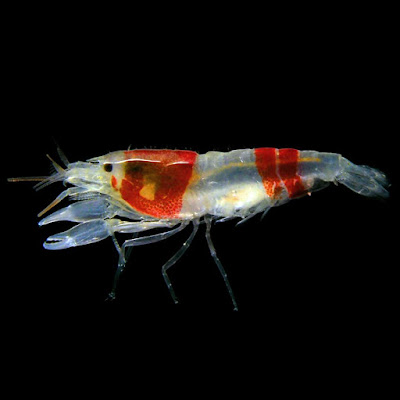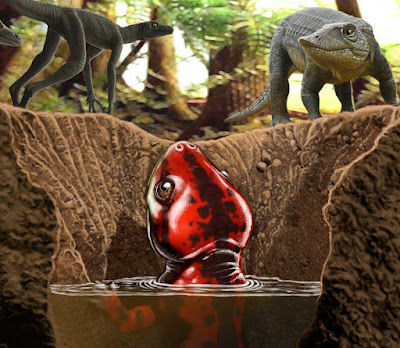[Most Recent Entries] [Calendar View]
Tuesday, June 20th, 2017
| Time | Event | ||||
| 9:41a | [Crustacea • 2017] Strongly Carinate Species of Alpheopsis Coutière, 1897 (Malacostraca: Decapoda: Alpheidae) of the Tropical Atlantic and eastern Pacific, with Redescription of A. trigona (Rathbun, 1901) and Description of Three New Species
Abstract The present study deals with four species of the alpheid shrimp genus Alpheopsis Coutière, 1897 characterised by the presence of at least one strong carina on the dorsal surface of the carapace. Alpheopsis trigona (Rathbun, 1901) is redescribed based on the holotype from Puerto Rico and additional material from US Virgin Islands and Florida. Two new species closely related to A. trigona, viz. Alpheopsis paratrigona sp. nov. and Alpheopsis gotrina sp. nov., are described, the first based on material from several localities in the tropical western Atlantic, and the second from the Pacific coast of Panama and Colombia. The three species together form a distinctive transisthmian clade within Alpheopsis, the A. trigona species complex, characterised by the presence of several strong longitudinal carinae on the carapace and very distinctive colour pattern. A more distantly related species, Alpheopsis aristoteles sp. nov., characterised by the presence of only one strong mid-dorsal carina in the anterior region of the carapace, is described based on material from São Tomé Island in the tropical eastern Atlantic. Keywords: Crustacea, Caridea, marine shrimp, biodiversity, East Pacific, West Atlantic, East Atlantic, Caribbean Sea, Gulf of Guinea Taxonomy Family Alpheidae Rafinesque, 1815 Alpheopsis Coutière, 1897 Alpheopsis paratrigona sp. nov. Etymology. The specific name refers to the general resemblance of the new species to A. trigona.
Alpheopsis gotrina sp. nov. Etymology. The new species’ name is an anagram of the specific epithet of its presumed closest relative, A. trigona. Alpheopsis aristoteles sp. nov. Etymology. The new species is named after the great Greek philosopher and scientist, Aristoteles (384–322BCE), and also the first naturalist who attempted a classification of animals based on morphology, anatomy and reproductive systems, in his famous “History of Animals” (Aristoteles 350 BCE). Arthur Anker. 2017. Strongly Carinate Species of Alpheopsis Coutière, 1897 of the Tropical Atlantic and eastern Pacific, with Redescription of A. trigona (Rathbun, 1901) and Description of Three New Species (Malacostraca: Decapoda: Alpheidae). Zootaxa. 4277(2); 199–227. DOI: 10.11646/zootaxa.4277.2.2 | ||||
| 3:54p | [Paleontology • 2017] Chinlestegophis jenkinsi • Stem Caecilian from the Triassic of Colorado Sheds Light On the Origins of Lissamphibia
Significance: Research into modern amphibian origins is increasingly focusing on the limbless caecilians, a poorly studied group whose pre-Cenozoic fossils are limited to two species. We describe tiny fossils from the Triassic of Colorado with a mixture of traits found in caecilians and extinct Permian–Triassic temnospondyls: Stereospondyli. Computed 3D tomography shows how skull bones organized around internal structures, and we suggest how these may have become fused or simplified in caecilians. The fossils’ association with burrows highlights ecological diversity of Triassic amphibians as well as when and how burrowing evolved in the stereospondyl ancestors of caecilians. Our narrative for research on amphibian origins highlights the importance of stereospondyls, the most numerous and anatomically diverse amphibian group of the Triassic. Abstract The origin of the limbless caecilians remains a lasting question in vertebrate evolution. Molecular phylogenies and morphology support that caecilians are the sister taxon of batrachians (frogs and salamanders), from which they diverged no later than the early Permian. Although recent efforts have discovered new, early members of the batrachian lineage, the record of pre-Cretaceous caecilians is limited to a single species, Eocaecilia micropodia. The position of Eocaecilia within tetrapod phylogeny is controversial, as it already acquired the specialized morphology that characterizes modern caecilians by the Jurassic. Here, we report on a small amphibian from the Upper Triassic of Colorado, United States, with a mélange of caecilian synapomorphies and general lissamphibian plesiomorphies. We evaluated its relationships by designing an inclusive phylogenetic analysis that broadly incorporates definitive members of the modern lissamphibian orders and a diversity of extinct temnospondyl amphibians, including stereospondyls. Our results place the taxon confidently within lissamphibians but demonstrate that the diversity of Permian and Triassic stereospondyls also falls within this group. This hypothesis of caecilian origins closes a substantial morphologic and temporal gap and explains the appeal of morphology-based polyphyly hypotheses for the origins of Lissamphibia while reconciling molecular support for the group’s monophyly. Stem caecilian morphology reveals a previously unrecognized stepwise acquisition of typical caecilian cranial apomorphies during the Triassic. A major implication is that many Paleozoic total group lissamphibians (i.e., higher temnospondyls, including the stereospondyl subclade) fall within crown Lissamphibia, which must have originated before 315 million years ago. Keywords: burrow, Gymnophiona, temnospondyl, tetrapod, Triassic
Tetrapoda Haworth, 1825 Temnospondyli Zittel, 1888 Stereospondyli Zittel, 1887 Chinlestegophis jenkinsi gen. et sp. nov. Etymology. Jenkins’s amphibian-serpent from the Chinle. “Chinle” for the Triassic Chinle Formation; “stego-” (Greek) meaning cover or roof, but commonly applied to temnospondyl amphibians and other early tetrapods; “-ophis” (Greek) meaning serpent. The species name honors paleontologist Farish Jenkins, whose work on the Jurassic Eocaecilia inspired the present study. Jason D. Pardo, Bryan J. Small and Adam K. Huttenlocker. 2017. Stem Caecilian from the Triassic of Colorado Sheds Light On the Origins of Lissamphibia. Proceedings of the National Academy of Sciences of the United States of America. in press. DOI: 10.1073/pnas.1706752114 Tiny fossils reveal backstory of the most mysterious amphibian alive today The discovery fills a significant gap in the evolutionary history of frogs, toads and other amphibians |
| << Previous Day |
2017/06/20 [Calendar] |
Next Day >> |



